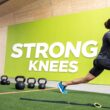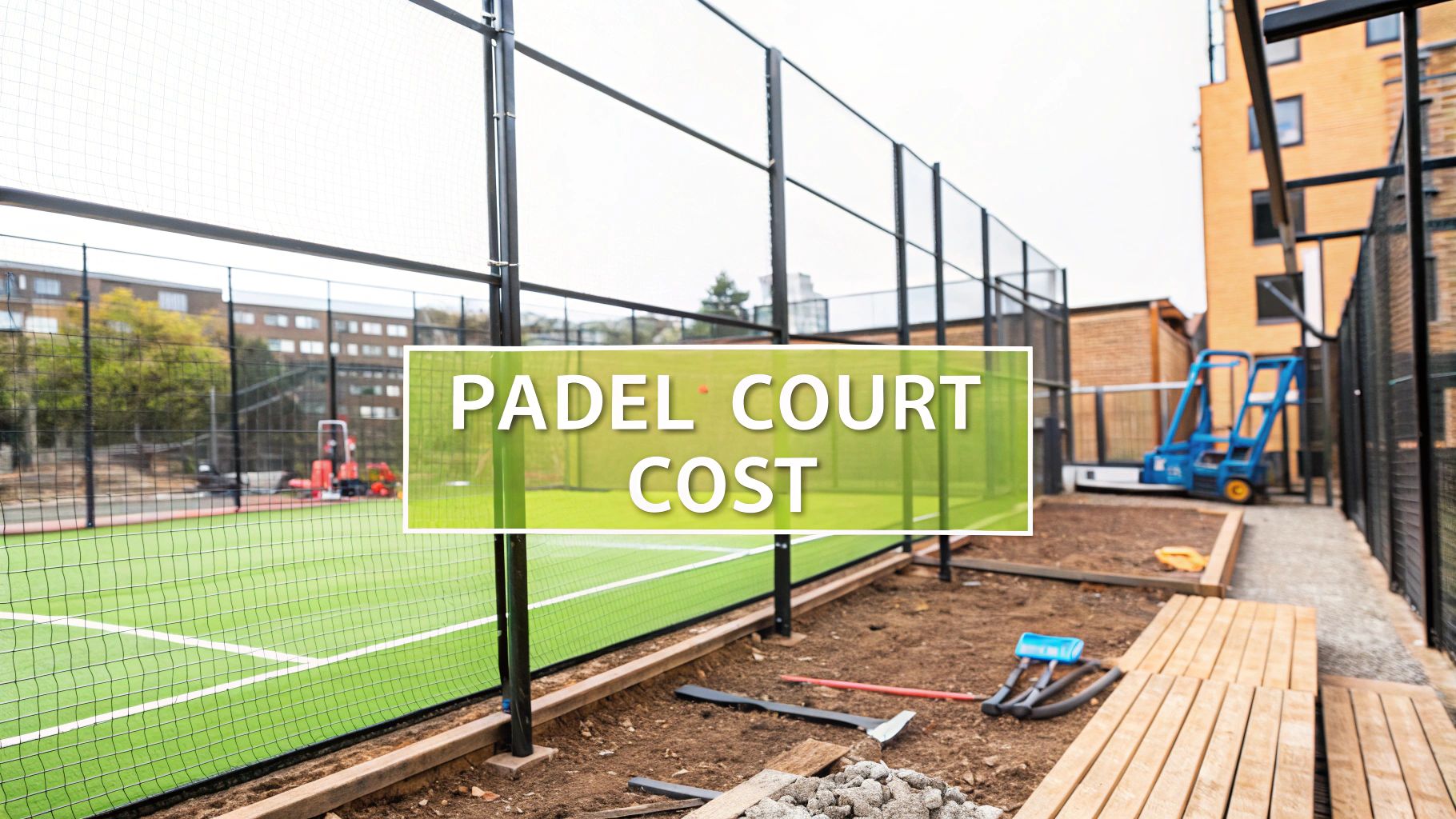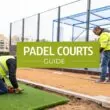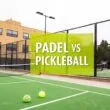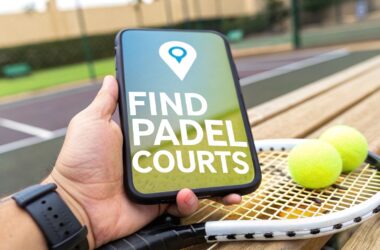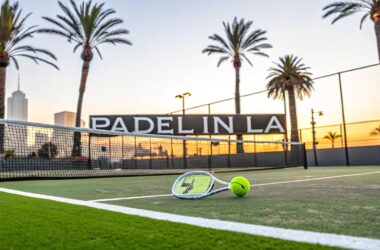Let's get right down to it. You're probably wondering what the real-world cost is to build a padel court. The number you'll hear most often is somewhere in the ballpark of €18,000 to €25,000.
But think of that figure as the starting point, not the finish line. The final invoice for your court can swing pretty dramatically depending on the specific model you choose, the condition of the ground you're building on, and any extra features you decide to add.
The Real Cost to Build a Padel Court
Figuring out the total investment for a padel court means you have to look way beyond the sticker price of the structure itself. The initial quote from a supplier usually covers the core components, but there are always other expenses that can pop up and inflate your budget. It's much less like buying a product off a shelf and more like managing a mini-construction project.
If you want to get a solid grasp on all the potential expenses—from permits and materials to those tricky hidden fees that come with any new build—it's worth checking out a complete budget guide for construction projects. This will help you see the bigger picture beyond just the court itself.

Buy the best padel gear to level up your next game!
CHECK OUT this deal from Padel Market!Get ready to take your game to the next level with the latest padel gear from Padel Market! Fast EU and Worldwide Shipping
To help you plan, we've summarized the main costs you'll face at the beginning of your project.
Padel Court Initial Cost Breakdown
Here’s a look at the primary cost categories you'll be dealing with and how they typically stack up in a project budget.
| Cost Component | Estimated Budget Percentage | Key Considerations |
|---|---|---|
| Structural Frame & Glass | 40-50% | Panoramic vs. standard design; glass thickness (10mm vs. 12mm). |
| Groundwork & Foundation | 25-35% | The biggest variable. Poor soil or sloped land will increase costs. |
| Artificial Turf | 10-15% | Monofilament is often preferred for playability but costs more than fibrillated. |
| Lighting & Accessories | 5-10% | LED lighting is standard. Accessories include nets, posts, and sand infill. |
| Labor & Installation | 10-20% | Varies by location and the complexity of the installation. |
This table gives you a solid framework for understanding where your money is going. The groundwork is often the wild card, so getting a thorough site assessment is crucial.
Breaking Down the Initial Budget
Let's dig a little deeper into those main components. These are the non-negotiable parts of any quality padel court, and they'll make up the bulk of your initial spend.
-
Structural Frame: This is the skeleton of your court. The cost here is driven by the material, like galvanized steel, and whether you go for a classic club-style court or a more open panoramic design with fewer posts.
-
Tempered Glass Walls: A signature feature of padel, the glass is also a major cost driver. You can opt for standard 10mm glass, but many clubs and homeowners are upgrading to 12mm glass for better durability and a more professional feel. This comes at a premium, of course.
-
Artificial Turf: The playing surface is critical. The type of turf you choose—like monofilament or the more traditional fibrillated—directly impacts ball bounce, player comfort, and how much maintenance you'll be doing down the road.
-
Groundwork and Foundation: This is where budgets get blown. If you don't get this right, nothing else matters. Proper excavation, leveling, and pouring a perfectly flat and stable concrete base are absolutely essential for the court's longevity and playability.
The price to build and install a quality padel court is generally between €18,000 and €25,000 in Europe. The higher end of that range usually accounts for premium materials and, more often than not, the necessary groundwork to create a solid foundation.
This financial overview should give you a realistic starting point. As we go, we'll break down each of these costs in more detail, but understanding these core pieces will help you have a much more productive conversation with potential contractors.
For the latest news on new club openings and court technology, you can always check out the latest updates on https://www.padelrumors.com/news/padel-courts/.
Decoding Core Component Costs
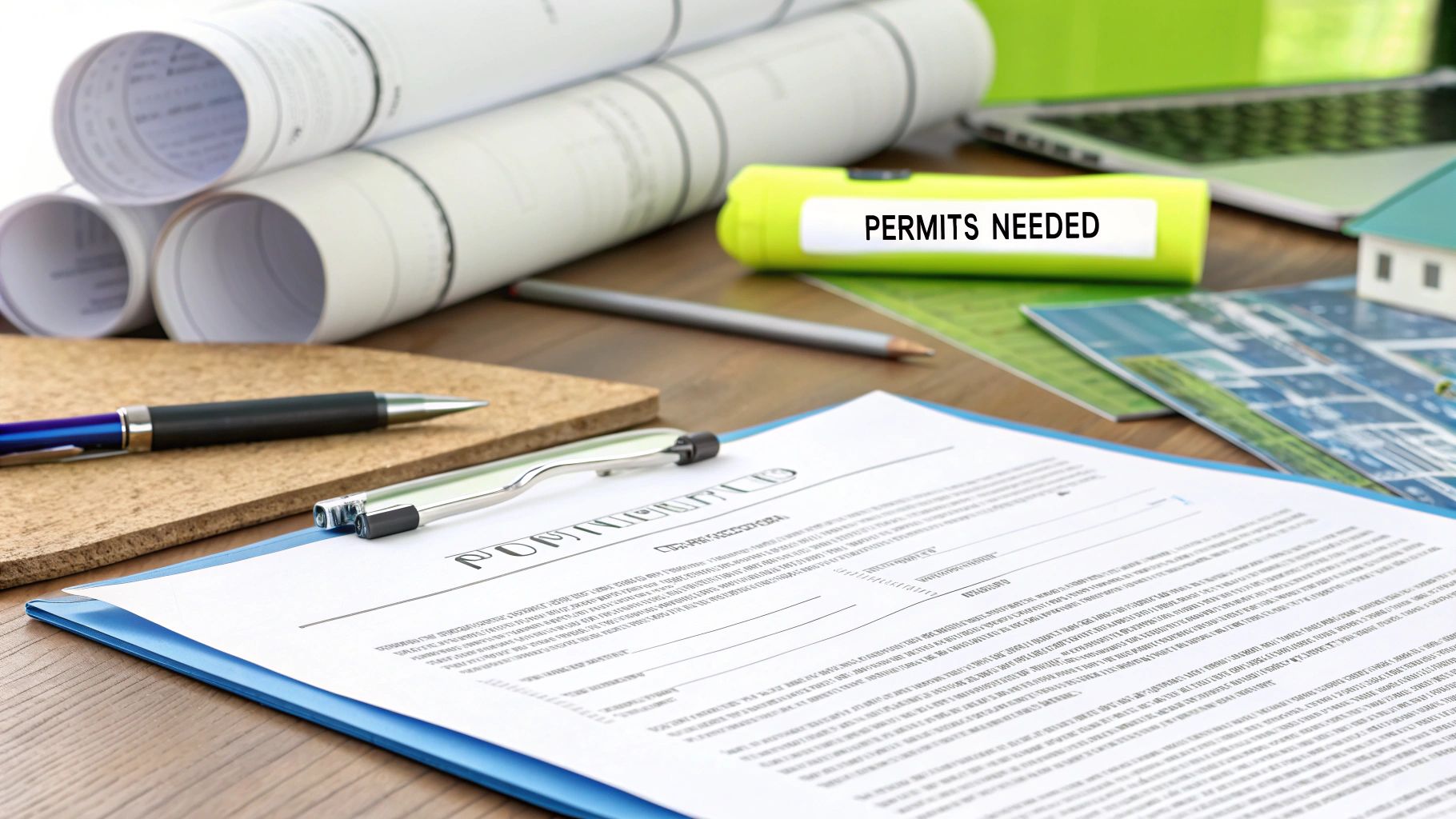
When you start digging into your budget, you’ll quickly find that the materials you pick are the financial heart of the whole project. We need to look past the simple price tags and understand the real-world value behind each piece of your padel court construction cost. The choices you make right here will shape everything from the player experience to your long-term maintenance headaches.
Think of the frame as the court's skeleton. A standard steel frame is common, sure, but spending a bit more upfront for a galvanized, powder-coated structure can save you thousands in rust prevention and repairs later on. This is especially true if you're in a humid or coastal climate. That initial investment truly pays for itself in the long run.
In the same way, your glass selection is about much more than just looks. It’s a huge cost driver that really defines the court's feel and quality.
Frame and Glass: The Visual and Structural Core
The big debate you'll run into is whether to go for a classic club-style court or spring for a premium panoramic setup. Panoramic courts are the ones you see on the pro tour—they use fewer, bigger structural posts, giving spectators a perfect, unobstructed view. For players, it just feels more high-end. That premium experience, as you might guess, comes with a higher price tag.

Buy the best padel gear to level up your next game!
CHECK OUT this deal from Padel Market!Get ready to take your game to the next level with the latest padel gear from Padel Market! Fast EU and Worldwide Shipping
Glass thickness is the other big decision you'll have to make:
- 10mm Tempered Glass: This is pretty much the industry standard for most recreational courts. It gets the job done, offering solid safety and performance at a cost-effective price point.
- 12mm Tempered Glass: This is a serious upgrade. It’s stronger, has better acoustics (you get a much more satisfying "thud" when the ball hits it), and gives the court a professional feel. If you're building a commercial club and want to attract serious players, this is the way to go.
Key Takeaway: While a panoramic court with 12mm glass can bump up your initial budget by 15-25%, it also seriously boosts the court's appeal. In a commercial setting, that means you can often charge higher rental fees to match.
The Playing Surface: Why Your Turf Choice Matters
The artificial turf is where the action happens. The type of fiber you choose directly impacts how the ball bounces, the speed of the game, and how much time you'll spend on upkeep. You're basically looking at a trade-off between upfront cost and long-term playability.
Here are the two main contenders:
- Fibrillated Turf: The fibers on this turf are designed to split apart, creating a dense, net-like surface. It's usually the cheaper option and does a great job of holding the sand infill. The downside? It can wear out faster and often leads to a slower, less consistent bounce over time.
- Monofilament Turf: This turf is made of individual, more resilient fibers. It’s known for being incredibly durable and offering top-notch playing characteristics. You get a truer, faster bounce, which is why it's the go-to for most modern and professional courts. The initial cost is higher, but its longevity often makes it the smarter investment.
On a global scale, the cost for a basic outdoor court can sometimes be surprisingly low. In certain markets, you might see a simple court advertised for around $9,800. Be warned, though—that number almost never includes critical costs like shipping, local labor, or the significant groundwork required. For a deeper dive into global price variations, check out the analysis over at GZUNIPADEL.
Ultimately, balancing the cost of these core components is the key to building a court that fits both your budget and your performance goals.
Uncovering Site Preparation Expenses
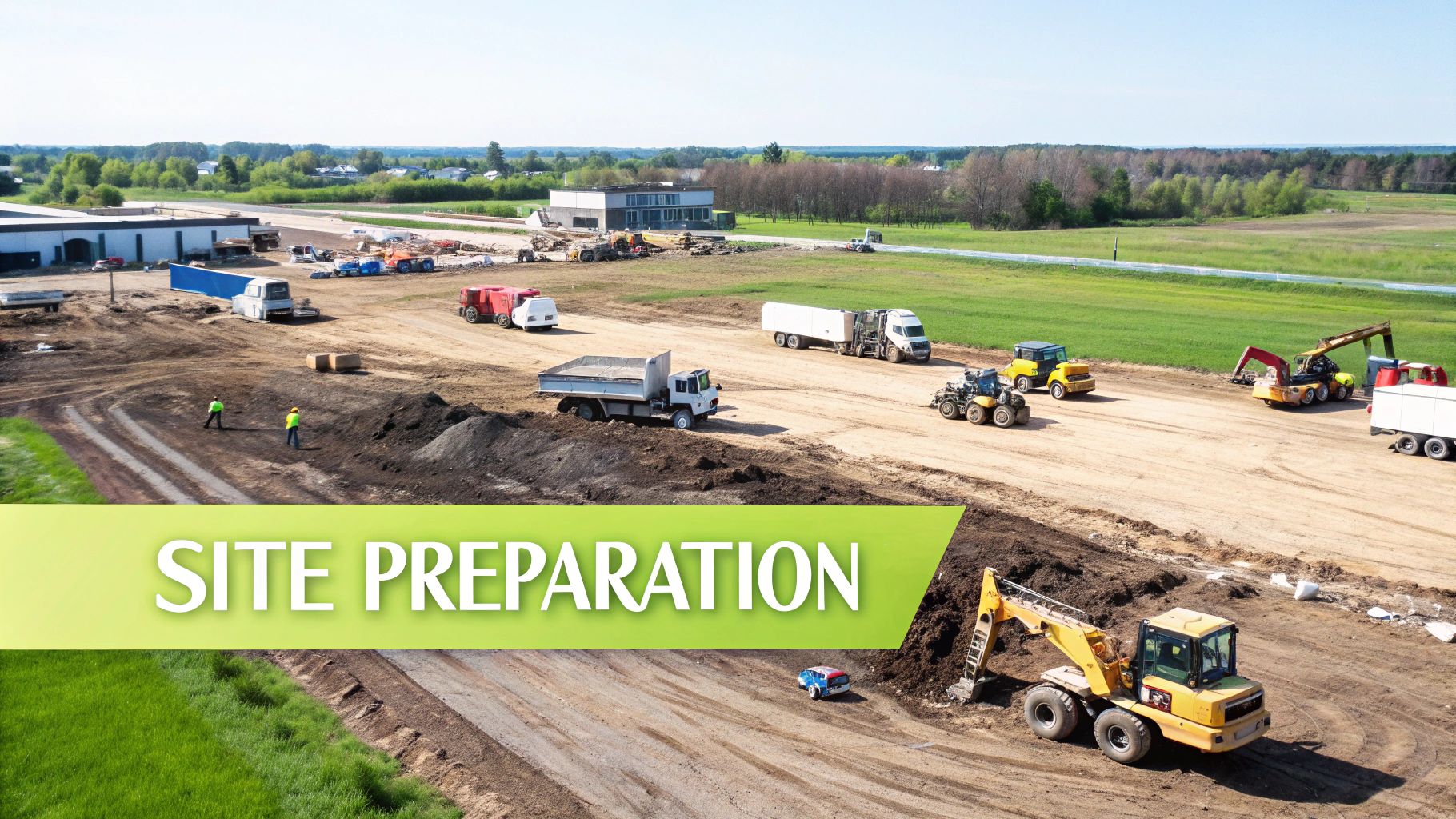
Before the first steel beam is set or a single glass panel is unwrapped, the most critical work happens right on the ground. Site preparation is the unsung hero of a durable padel court, and it's also where budgets can get seriously derailed. I've seen it time and time again.
This foundational stage is a huge piece of the overall padel court construction cost, often eating up 25-35% of the entire project budget.
Many first-time builders get a quote for the court structure itself and just assume the groundwork will be a minor expense. That’s a costly mistake. The stability, drainage, and long-term playability of your court depend entirely on what it’s built on. Cutting corners here is a recipe for cracked concrete, uneven surfaces, and expensive repairs down the line.
A crucial first step is always preparing the site. You can dive deeper with this comprehensive guide to excavation and land clearing, which breaks down the entire process. This work ensures your location is primed and ready for a rock-solid foundation.
From Raw Land to a Perfect Foundation
The whole process kicks off with a professional land survey to figure out the topography. Is your chosen spot perfectly flat, or does it have a subtle slope? Even a slight incline can add thousands to your excavation and leveling costs. A good surveyor will spot potential headaches before the digging even starts.
Next, the heavy machinery rolls in. The topsoil gets stripped away, and the area is excavated to the required depth. The goal is simple: create a perfectly level and compacted sub-base. This is absolutely essential for preventing the concrete slab from shifting or cracking over time.
A few things can really swing the cost here:
- Soil Conditions: Got loamy, stable soil? Perfect. That's the easy route. But if you're dealing with clay-heavy or sandy soil, you might need extra reinforcement or different base materials, which will definitely inflate the cost.
- Drainage Systems: For outdoor courts, proper drainage is non-negotiable. Installing a French drain or building in a slight, imperceptible slope will stop water from pooling on the playing surface, which can wreck the turf and the foundation.
- Accessibility: Think about how easily heavy equipment like excavators and concrete trucks can get to the site. A tight backyard with narrow access might mean using smaller, less efficient machinery, which adds up in labor hours and overall expense.
My Takeaway: A perfectly poured, reinforced concrete foundation is the only base I'd ever recommend for a professional-quality padel court. Anything less, like a simple compacted gravel base, will inevitably lead to structural problems and an uneven, frustrating playing surface.
Real-World Scenarios That Wreck Budgets
Let's imagine two different backyard projects. The first is on a flat, easily accessible lot with good soil. Site prep here might be pretty straightforward, landing on the lower end of the budget.
Now, picture a second yard on a hill with terrible drainage. This project is going to need significant excavation to carve out a level terrace, a retaining wall to hold back the soil, and a serious drainage system. These factors can easily double the site prep costs compared to the first, simpler scenario.
When you're planning a new venue, understanding these variables is a huge part of the puzzle. We touch on more of these in our guide covering the key aspects to consider when opening a padel venue. Always, always ask potential contractors for a detailed, itemized quote that specifically breaks down every single step of the site preparation.
Budgeting for Essential Add-Ons and Features
A playable court is more than just a foundation, turf, and glass. The extras are what really take a basic structure and turn it into a top-notch facility, and they definitely play a big part in your total padel court construction cost. Factoring these features into your budget from day one is the best way to avoid nasty financial surprises down the road.
These add-ons aren't just for show; they have a direct impact on the player experience, safety, and the court's overall return on your investment. Whether it's for your private backyard court or a commercial club, setting aside a chunk of your budget for these elements is just plain smart.
This graphic breaks down where the money typically goes in any padel court build.
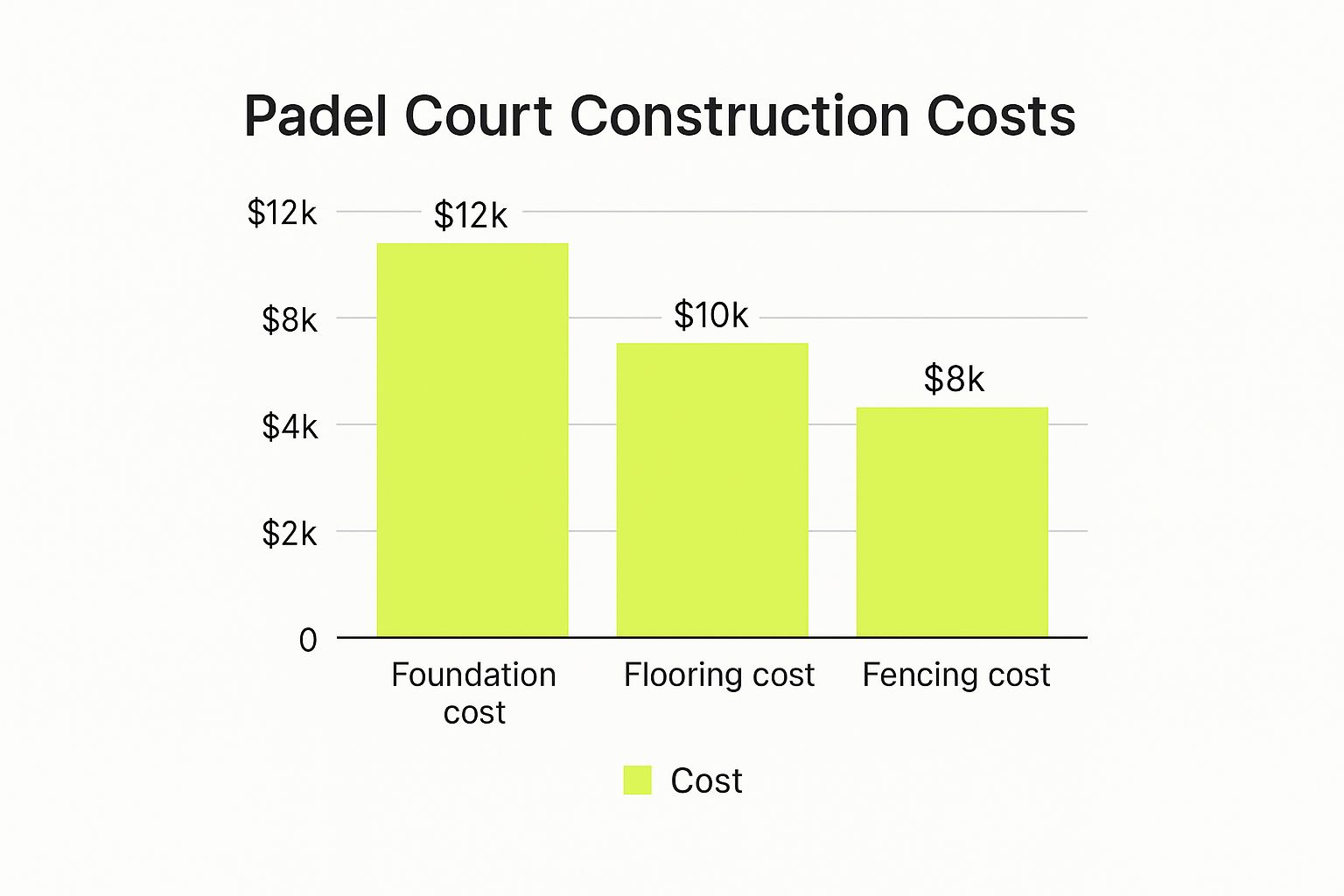
As you can see, the foundation and the court surface itself eat up the biggest slice of the pie. It really drives home how critical it is to get these core components right from the start.
Lighting for Night Play
One of the most valuable upgrades you can make is a quality lighting system. Good lights extend playing hours well into the evening, which is an absolute must for commercial clubs trying to maximize court bookings and bring in more revenue.
For the best visibility and long-term savings, you should seriously look into modern options like commercial LED lighting upgrades. Yes, the upfront cost for LEDs might be a bit higher than old-school lighting, but the energy savings and lower maintenance costs give you a clear financial win over time.
Shelter and Player Comfort
Protecting your investment and getting the most playing time out of it is another huge consideration. A canopy or a full roof might feel like a luxury, but in places with a lot of rain or intense sun, it's a total game-changer. It keeps the turf in better shape, cuts down on maintenance, and means the game goes on, no matter what the weather is doing.
Think about these features, too:
- Player Benches: A simple but essential touch for comfort between games.
- Net and Posts: This is a non-negotiable. The quality here affects everything from durability to proper net tension.
- Access Gates: Your options can range from a basic manual gate to more secure, automated systems perfect for clubs.
Here's a quick look at how the costs and benefits of these common add-ons stack up.
Feature Cost and Benefit Comparison
| Feature | Estimated Cost Range | Primary Benefit |
|---|---|---|
| LED Lighting System | $4,000 – $10,000 | Extends playing hours, increases revenue potential, and offers long-term energy savings. |
| Canopy/Roof | $10,000 – $30,000+ | Provides all-weather playability, protects the court surface, and reduces maintenance. |
| Player Benches | $300 – $1,500 | Enhances player comfort and provides a designated rest area during matches. |
| Upgraded Net System | $500 – $2,000 | Ensures professional-level net tension, durability, and a better playing experience. |
| Scoreboard | $200 – $2,500 | Adds a professional touch and makes it easy for players and spectators to track the score. |
Choosing the right features really comes down to your specific needs and how you plan to use the court.
Key Insight: For a commercial club, a canopy can literally pay for itself by eliminating weather-related cancellations. For a private court, it means you get to use your investment whenever you feel like it.
The explosive growth of padel has really shaken up the market for all these components. Consider this: over 40,000 new padel courts were installed globally in just one recent year, with Europe leading the way. This boom has created fierce competition among builders and suppliers, which can swing the pricing and availability of everything from light fixtures to roofing materials.
At the end of the day, it all comes down to your goals. A private court might only need some basic lighting and a couple of benches. A commercial facility, on the other hand, will see a fantastic return from investing in things like a canopy and other premium player amenities.
Navigating Installation and Logistic Costs
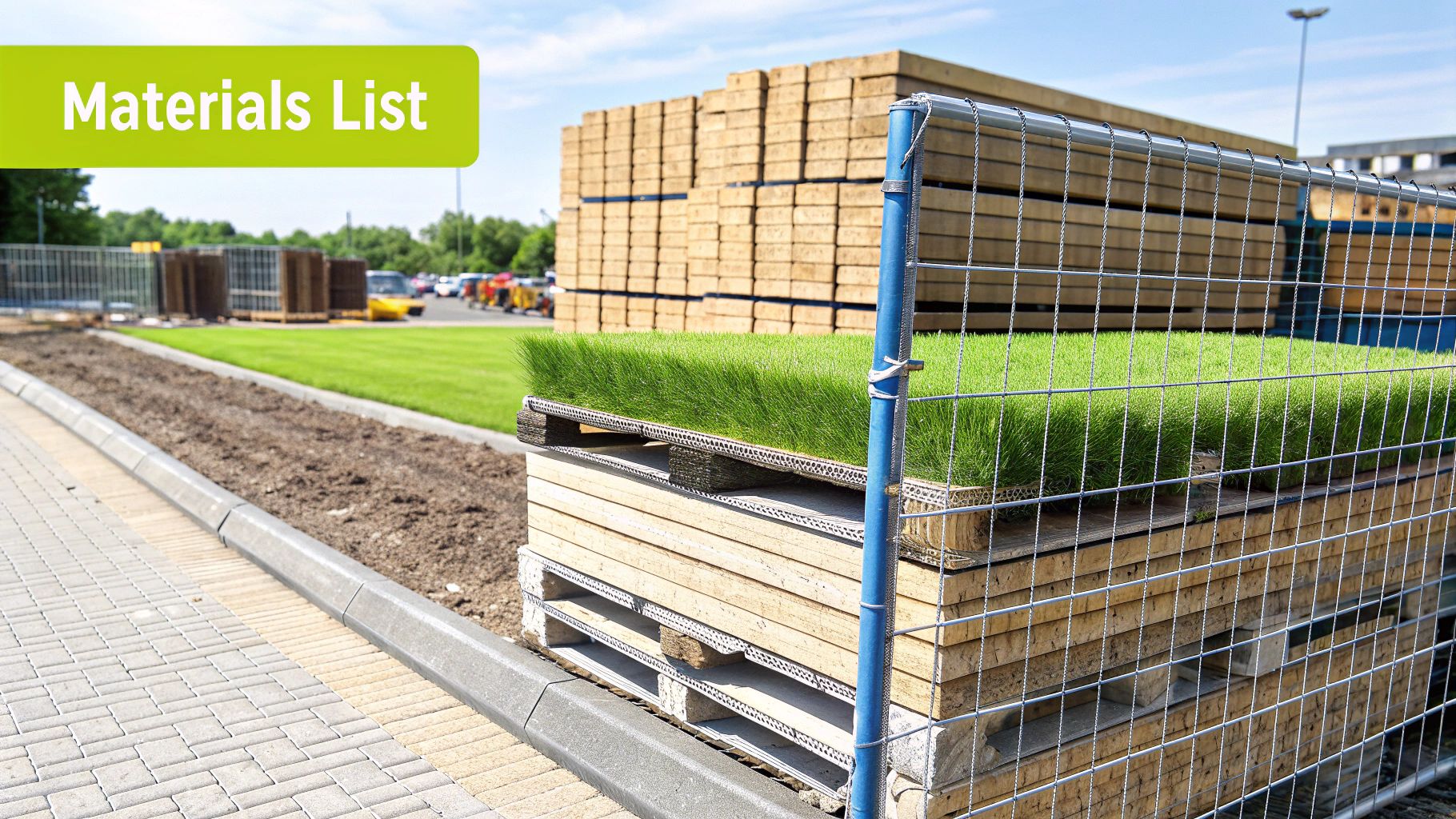
You can pick out the best materials in the world, but they're not worth much without an expert crew to put them all together. This part of your padel court construction cost is all about the human element, and honestly, it’s one of the most critical pieces of your entire budget.
Getting this right means partnering with a skilled, qualified team. Think of it as protecting your investment.
Labor rates can swing wildly depending on where you are and how tricky your project is. For instance, squeezing a court into a tight, hard-to-reach backyard is almost guaranteed to cost more than a straightforward build on a wide-open, level plot of land.
Finding and Vetting Your Installation Team
The quality of your installation crew has a direct line to the court's safety, how long it lasts, and how well it plays. A poorly installed glass panel or a turf seam that isn't quite right isn't just a cosmetic issue—it's a genuine hazard waiting to happen.
When you're shopping for a team, don't be shy. Insist on seeing a portfolio of their past work. You'll want to ask for references from previous clients and, if you can, go visit a court they’ve built. A true professional will be proud to show off what they can do.
Your quote should be more than just a single number at the bottom of a page. A detailed, itemized quote is the hallmark of a pro. It needs to clearly break down:
- Labor hours and rates for every stage of the build.
- Equipment rental fees, like for cranes or forklifts.
- Material transport and shipping costs.
- Site cleanup and waste disposal charges.
This kind of detail is your best defense against those fuzzy "miscellaneous" fees that can mysteriously inflate a final bill. It also gets you and the contractor on the exact same page. Knowing the nuances between indoor and outdoor builds helps, too—you can get a better feel for this by checking out the specifics of constructing https://www.padelrumors.com/news/indoor-padel-courts/.
Pro Tip: Never, ever choose an installer based on price alone. A bid that seems too good to be true is often a massive red flag. It could mean they're inexperienced, cutting corners on materials, or hiding costs that will pop up later.
Uncovering Hidden Logistic Expenses
Logistics are the unsung costs of any major construction project, and they can easily sneak up on you if you're not prepared. These are all the expenses tied to getting materials and heavy equipment to your site and into position. Forgetting to budget for them can cause some serious last-minute financial headaches.
The biggest logistical surprise for most people? The need for a crane. Those tempered glass panels are incredibly heavy, with some weighing over 400kg a piece. You can't just carry them into place. Lifting them safely over a house or into a confined space requires specialized equipment, and that comes with a hefty rental fee.
Other logistical costs you should plan for include:
- Freight Shipping: Your court components might be traveling hundreds, if not thousands, of miles to get to you.
- Material Storage: If there’s a gap between when your materials arrive and when installation starts, you might have to pay for secure storage.
- Site Access Prep: Sometimes, you even have to build a temporary road or pathway just to get the heavy machinery onto the site.
Talk through all these variables with potential installers from the very beginning. That's how you get a truly comprehensive quote that covers every single angle of the build, ensuring there are zero financial surprises when the job is done.
Answering Your Top Padel Court Questions
As you get closer to breaking ground, you’re bound to have a few big questions. Thinking through the long-term commitments and processes beyond just the build is a massive part of managing your total padel court construction cost. Let's tackle some of the most common things potential court owners ask.
What Does Annual Padel Court Maintenance Cost?
The good news is that keeping your court in pristine condition isn't going to break the bank. You should budget somewhere between €500 and €1,500 per year for regular maintenance. It's a small price to pay to protect your much larger investment.
This yearly cost typically covers a few key jobs:
- Regular Turf Brushing: This keeps the sand infill spread out evenly, which is absolutely vital for a consistent ball bounce and safe player footing.
- Deep Cleaning: A pro deep clean once in a while will stop moss and algae from growing. That stuff can make the surface incredibly slippery and dangerous.
- Structure and Glass Check: Just a routine inspection of the frame and glass panels to catch any potential problems before they become serious.
- Net Tension Check: Making sure the net is always at the right height and tension gives players that professional experience they're looking for.
Could I Just Build a DIY Padel Court to Save Money?
I get the temptation. A DIY build seems like a great way to slash labor costs, but for a padel court, it's almost always a bad idea. The level of precision needed is miles beyond your average backyard project.
The foundation is the first major roadblock. You need a perfectly level, properly reinforced concrete slab. Even a minuscule error in the slope can lead to drainage nightmares and a surface that’s basically unplayable. That's a job for seasoned pros, period.
Then you have the glass. A single tempered glass panel can weigh over 400kg. Trying to lift and install these without specialized gear and a highly experienced crew isn't just a costly risk—it's a massive safety hazard.
Any money you think you're saving on labor will likely get eaten up (and then some) by the cost of fixing mistakes. Going with a professional installer is the smarter financial move in the long run, protecting both your investment and the people who play on it.
How Long Does the Whole Construction Process Take?
From the first shovel in the ground to the last turn of the net crank, you should expect the entire construction process to take somewhere between four and eight weeks.
The biggest variable is always the groundwork. The excavation, pouring the foundation, and letting the concrete cure is the longest part of the job, usually taking two to four weeks on its own. You absolutely cannot rush the curing process; it’s what gives the slab its strength and longevity.
Once that foundation is solid and ready, things move a lot faster. A professional crew can usually get the frame, glass, turf, and lights up in about 7 to 10 days. Of course, always build in a little buffer for things you can't control, like bad weather or permitting delays.
Do I Actually Need a Permit to Build a Padel Court?
Yes. In pretty much every situation, you will need a permit. A padel court, with its permanent concrete base and lighting towers, is considered a permanent structure by most local governments. That means you'll almost certainly need to get planning permission before any work can start.
The process usually means submitting detailed site plans and drawings for approval. I can't stress this enough: start this as early as possible. Depending on how efficient your local municipality is, securing the right permits can take anywhere from a few weeks to several months. This is a non-negotiable step that has to be done before you break ground.
Ready to dive deeper into the world of padel, from finding local courts to picking the perfect racket? Explore Padel Rumors for comprehensive guides, player news, and the latest gear reviews at https://www.padelrumors.com.



